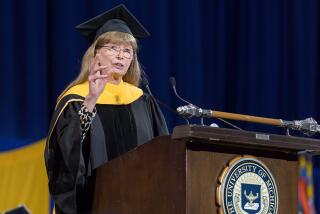Robert W. Taylor, visionary figure in the birth of personal computing and the Internet, dies at 85
- Share via
In 1968, Robert W. Taylor made a prediction that would guide the course of computer science for decades to come.
“In a few years,” he wrote, “men will be able to communicate more effectively through a machine than face to face.”
Taylor, who died Thursday at the age of 85, became the single most important force in making his own vision come true. As a civilian official at the Pentagon’s Advanced Research Projects Agency in the 1960s, he approved the funding to launch the government computer network that would ultimately evolve into the Internet.
And as one of the original laboratory chiefs at the fabled Xerox Palo Alto Research Center, or PARC, he supervised the work that produced the first personal computer; the graphical user interface that was the model for Microsoft Windows and the Apple Macintosh display; the laser printer; the Ethernet local network; and many more advances.
The programmed digital computer ... can change the nature and value of communication even more profoundly than did the printing press and the picture tube.
— Robert Taylor and J.C.R. Licklider, predicting the digital future in 1968
Taylor, who suffered from Parkinson’s disease and other ailments, died at his home in Woodside, Calif., according to his son Kurt.
Taylor may have been little-known to the general public, but he was a revered figure among computer scientists and designers — many of whom received their earliest funding or developed their pioneering concepts with his help. Taylor’s lab at PARC spawned companies and concepts that would help to place California’s Silicon Valley at the center of the digital business world.
“From the early 1960s, Bob always had a very clear vision of the potential of the computer at a time when very few other people had really grasped it,” recalled Butler Lampson, one of the designers of the Alto, PARC’s groundbreaking personal computer. “He certainly was the one with the overarching vision of what we were trying to accomplish.”
Born in 1932 in Dallas, Taylor never lost the West Texas twang he acquired during his Depression-era upbringing as the adopted son of a Methodist minister and his wife. He earned a master’s degree in psychology at the University of Texas and eventually joined the Pentagon as a research official.
His superior, psychologist J.C.R. Licklider, was devoted to “finding ways to make computers easier to use” — and especially making them interactive, Taylor recollected years later. At that time, computers were room-size monstrosities that operated on the “batch” principle. A user would write an entire program on punch cards or spools of punched tape, feed it into the machine, wait for it to be processed, and then correct or rewrite it and feed it all back in. “It was an unbelievable rigmarole,” Taylor recalled. Moreover, every brand of computer ran on a proprietary language that made them all mutually unintelligible.
At the Advanced Research Projects Agency, Taylor witnessed the drawbacks of this arrangement firsthand. He had three terminals in his office, each linked to a computer project he was funding at three separate academic institutions. They could communicate with him, but not with one another, which prevented rather than fostered collaboration among ARPA’s researchers.
“You don’t have to be half-smart to see that this thing ought to be designed such that you just have one terminal and you can go wherever you want to go,” Taylor explained many years later. In 1966, he proposed such a system to ARPA’s chief, Charles Herzfeld, who saw the point immediately and approved the “million dollars or so” Taylor told him he needed to get the project off the ground.
“That,” Taylor remembered years later, “was literally a 20-minute conversation.” From that conversation was born the ARPAnet, which over the ensuing decades evolved into the Internet.
By 1969, Taylor had become disaffected with ARPA, which was losing its independence as a civilian research unit and becoming more focused on military projects related to the Vietnam War. He left the agency, and soon after received an invitation from Xerox, which was launching a research outpost on the West Coast. Xerox hoped to diversify beyond its enormous franchise in large-scale office copiers and develop technologies for what it called the “office of the future.” The new operation, founded in 1970 as its Palo Alto Research Center — a year before the term “Silicon Valley” first appeared in print — became better-known as Xerox PARC.

Shortly after arriving in Palo Alto, Taylor stopped by the desk of a secretary who was showing off her new IBM Selectric typewriter, which used a distinctive golf ball-shaped mechanism to imprint letters on paper. He tapped it with his finger and said, “We’re going to make this thing obsolete.”
He was right. Taylor assembled a brilliant team of resourceful computer designers in part by raiding the academic programs he had funded at ARPA. He passed on his vision that the computer should be an interactive device, which responded command-by-command to its users’ needs.
In their 1968 manifesto “The Computer as a Communication Device,” Licklider and Taylor asserted that the “programmed digital computer … can change the nature and value of communication even more profoundly than did the printing press and the picture tube.” The goal was “making the response time short and the conversation free and easy” in a network of computers — not just in one machine.
The problem was that the hardware and software necessary to make this vision real didn’t exist yet. Taylor’s lab at PARC invented it. His hand-picked team included Lampson and Charles Thacker, who were brilliant at computer design, and Alan Kay, a seminal thinker who perceived the computer as a device to enhance individual creativity. They believed the computer should be endowed with a high-quality display, on the principle that the most efficient path to the human brain came through the eyes.
Kay, Lampson and Thacker designed and built the first personal computer, the Alto, following a path that Taylor laid out in rough strokes: “He would set down broad goals and coax us into working on them,” Lampson recalled.
The Alto was equipped with a screen about the size and orientation of a paper page, and a graphical display that became the precursor of Microsoft Windows and Apple’s Macintosh screen. The Alto was a genuinely personal device — every PARC computer scientist soon had his or her own — and began to approach the computing power to fulfill Kay’s dream of a computer that could not only perform calculations, but allow “the communication of the owner with himself.”
Lacking formal training in computer science or engineering, Taylor created the environment for his scientists —typically willful, intellectually self-confident, and self-absorbed — to do their work. It may have been his greatest accomplishment. He instituted weekly team meetings known as “Dealer,” after the book “Beat the Dealer,” which described a winning blackjack system. At Dealer, the scientists would sit on hideously upholstered beanbag chairs to subject a presenter’s work or theory to ruthless, sometimes rude, but invariably incisive critiques. The idea was to create the sense of an extended family amid the unfettered testing of ideas — with the ideas the key element.
“If somebody tried to push their personality rather than their argument,” Taylor recalled, “they’d find that it wouldn’t work.”
“He knew how to get lone wolves to cooperate so there was maximum synergy in the room,” Kay said. Taylor also expended enormous energy building a wall around his team to fend off constant pressure from Xerox to align their work with the corporation’s most immediate goals. This generated friction not only with corporate management, but with other labs at PARC that were competing with his computer scientists for corporate resources.
“He showed maximum pugnaciousness upward,” Kay said, “and maximum nurturing downward.” Taylor’s “key idea,” Kay added, was to “fund people, not projects” — bringing together the best scientists in the world to solve the problems they thought were the most important.
In time, Taylor and his team became frustrated by Xerox’s inability or unwillingness to commercialize their work. In December 1979 the first breach in PARC’s wall occurred after Apple’s Steve Jobs accepted an investment from Xerox on condition that he get a look inside the research center. During two separate demonstrations, Jobs and his associates were shown the Alto and much of its key software. Many of the concepts made their way into the Lisa, Apple’s first large-scale product.
Some Apple engineers would try to minimize how much they gleaned from these visits, but there was little doubt that both Apple and Microsoft took PARC’s display and other features of its work as a model for their own software. According to Walter Isaacson’s 2011 biography of Jobs, Microsoft’s Bill Gates answered Jobs’ accusation that Microsoft had stolen the Windows graphical display from Apple by observing, “It’s more like we had this rich neighbor named Xerox and I broke into his house to steal the TV set and found out that you had already stolen it.”
Taylor’s determined defense of his team eventually led to his unhappy departure from PARC. In 1981, new management arrived at the research center determined to align the center, especially Taylor’s team, with corporate goals. By September 1983, Taylor had been goaded into resigning.
Taylor moved to Digital Equipment Corp., where he presided over more advances, including the early search engine AltaVista. But he never matched the accomplishments of his PARC years, in part because the advances there had seeded so many other new technologies that it became difficult for any single lab to remain in the forefront for long.
Indeed, after Taylor’s departure, the trickle of resignations by PARC scientists seeking new outlets for their work turned into a flood — and his influence is visible in almost every corner of the digital world today. Software designer Larry Tesler moved to Apple; Hungarian immigrant Charles Simonyi, who had developed Bravo, a word-processing program on what-you-see-is-what-you-get (or WYSIWYG) principles to take advantage of the Alto’s display, took his program to Microsoft, where it became the kernel of Microsoft Word. Robert Metcalfe, the co-inventor of Ethernet, founded 3Com Corp. to commercialize the technology, and programming aces Charles Geschke and John Warnock left to found Adobe Systems Inc.
“He was one of those unique people,” Kay said, “who was a central factor in a deep revolution of ideas.”
Times staff writer Esmeralda Bermudez contributed to this report.
UPDATES:
2:58 p.m., April 17: This article has been updated with the date of Taylor’s resignation from PARC.
More to Read
Start your day right
Sign up for Essential California for the L.A. Times biggest news, features and recommendations in your inbox six days a week.
You may occasionally receive promotional content from the Los Angeles Times.









